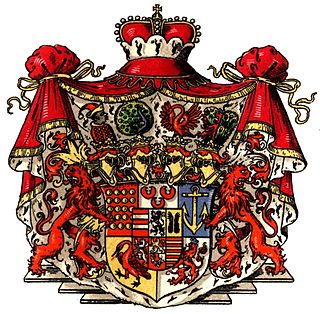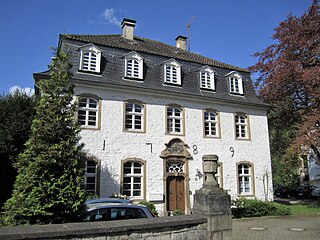This article needs additional citations for verification .(October 2016) |

Bentheim-Tecklenburg was a German county, later principality, based in the region around Tecklenburg in northern North Rhine-Westphalia, Germany.
This article needs additional citations for verification .(October 2016) |

Bentheim-Tecklenburg was a German county, later principality, based in the region around Tecklenburg in northern North Rhine-Westphalia, Germany.
Bentheim-Tecklenburg emerged as a partition of the County of Bentheim in 1277, and was partitioned between itself and Bentheim-Lingen in 1450. Count Conrad converted his county to Lutheranism in 1541. In 1557, it was inherited by Bentheim-Steinfurt.

Arnold III, Count of Bentheim-Steinfurt-Tecklenburg-Limburg (1554-1606) held the counties of Bentheim, Tecklenburg, Steinfurt, Limburg (with Hohenlimburg Castle), the Lordship of Rheda, possessions on the Lower Rhine and bailiff rights in the Archbishopric of Cologne. After his death his possessions were divided between his three eldest sons while the younger sons received lands from their mother. Adolf (1577-1623) received Tecklenburg and Rheda, Wilhelm Heinrich (1584-1632) Steinfurt (with Burgsteinfurt Castle), but left no offspring, Konrad Gumprecht (1585-1618) received Limburg, but his only son died early. Adolf had four sons of whom Moritz (1615-1674) inherited Tecklenburg and Rheda in 1623 and Limburg in 1629. Moritz' two sons Johann Adolf (1637-1704) and Friedrich Moritz (1653-1710) partitioned the territories again, but in 1701 Brandenburgian troops occupied Tecklenburg, as there had been a dispute about the county with the counts of Solms-Braunfels since 1577, and the latter sold their rights to Brandenburg.
After the loss of Tecklenburg, the family still ruled in Limburg and Rheda, however about 100 kilometers apart from each other. In 1756 the residence was moved from Hohenlimburg to Rheda, which remains the main seat of the family to this day. In 1803 the secularized monasteries of Herzebrock and Clarholz, both located within the territories, were taken over by the counts. However, their sovereignty ended with the mediatisation in 1808 when the county became part of the Grand Duchy of Berg, and after the Congress of Vienna (1815) of the Kingdom of Prussia. In 1817, the count was created 1st Prince of Bentheim-Tecklenburg and Rheda by the Prussian king. In 1854 he received a hereditary seat in the Prussian House of Lords. The castles of Hohenlimburg and Rheda and the abbeys of Herzebrock and Clarholz are still today owned by the House of Bentheim-Tecklenburg-Rheda.

Tecklenburg is a town in the district of Steinfurt, in North Rhine-Westphalia, Germany. Its name comes from the ruined castle around which it was built. The town is situated on the Hermannsweg hiking trail.

Count John VI of Nassau-Dillenburg was the second son of William the Rich and the younger brother of William the Silent. He has a special place in the history of the Netherlands because he is the male-line forefather of the House of Orange.

Bentheim-Tecklenburg-Rheda was a historical county of the Holy Roman Empire, located in present northwestern North Rhine-Westphalia and southwestern Lower Saxony, Germany.

Bentheim-Steinfurt was a historical county located in northwestern North Rhine-Westphalia in the region surrounding Steinfurt, Germany. Bentheim-Steinfurt was a partition of Bentheim-Bentheim, itself a partition of the County of Bentheim. Bentheim-Steinfurt was partitioned: between itself and Bentheim-Tecklenburg-Rheda in 1606; and between itself and Bentheim-Bentheim in 1643.

The County of Bentheim was a state of the Holy Roman Empire, located in the south-west corner of today's Lower Saxony, Germany. The county's borders corresponded largely to those of the modern administrative district (Landkreis) of Grafschaft Bentheim.

Hagen-Hohenlimburg, on the Lenne river, is a borough of the city of Hagen in North Rhine-Westphalia, Germany.
These are lists of political office-holders in Germany.

The County of Tecklenburg was a state of the Holy Roman Empire, located in the present German state of North Rhine-Westphalia and Lower Saxony.
Alexius Frederick, Prince of Bentheim and Steinfurt was a German nobleman.

Elsey Abbey, earlier Elsey Priory, is a former women's religious house located near Elsey, now part of Hohenlimburg, Hagen, Germany.

Arnold III of Bentheim-Tecklenburg-Steinfurt-Limburg was a German nobleman. He was Count of Bentheim, Tecklenburg and Steinfurt, and jure uxoris Count of Limburg. He ruled as Arnold IV in Bentheim and Tecklenburg, and as Arnold II in Steinfurt. In Limburg, he was the first Count named Arnold and hence just the name distinctive.
Magdalena of Neuenahr-Alpen was a German noblewoman. She was the heiress of the House of Neuenahr-Alpen; she inherited the County of Limburg. By marriage, she was Countess of Tecklenburg.

Eberwin III, Count of Bentheim-Steinfurt was a German nobleman. He was a member of the elder line of the House of Bentheim-Steinfurt and was the ruling Count of Bentheim and Steinfurt from 1544 until his death. From 1557, he was also Count of Tecklenburg and Lord of Rheda by marriage.
Bentheim may refer to:

Diederik III of Limburg Hohenlimburg, born around 1328, was the eldest son of Everhard II van Limburg Hohenlimburg and Juta of Sayn. Twenty years later he followed the 9th of August 1364 his grandfather Diederik II count of Limburg Hohenlimburg. In 1366 Diederik III became the Amtmann of Angermünde, the district between Duisburg and Düsseldorf. As the successor to lord Diederik III of Broich, who five years later would become his father-in-law. He also was Voght of the Rellinghausen Abbey. On 3 July 1371 Diederik married Ludgardis (Lukarda) daughter of Diederik of Broich and Katharina of Steinfurt. Lukarda was heiress of the Lordship Broich. At his wedding, he received a dowry of 1,600 old gold shields.

The brothers counts Willem II and Hendrik I, sons of Diederick IV count of Limburg Hohenlimburg Broich and Lukardis of Broich succeed each other as Count of Limburg Hohenlimburg Broich. In 1446, two years after the death of their father Diederick. The Archbishop of Cologne, after the conquest of Broich castle handed over his share of Broich to Willem II of Limburg. The Duke of Gullick-Berg also returned his share of Broich. Willem had to reconfirm provisions that his father Diederik IV had agreed upon in 1430. Brother Hendrik of Limburg continued to fight for the Cleves party. It was not until April 7, 1454, that he agreed to waiver of his Lordship rights to Broich.
Anna von Tecklenburg-Schwerin (1532-1582) was the ruling suo jure Countess of Tecklenburg and the lordships of Wevelinghoven and Rheda between 1557 and 1582. She was regent of the County of Bentheim-Steinfurt during the minority of her son in 1562–1573.

The House of Bentheim is one of the oldest extant German noble families. They are a mediatized family, formerly being rulers of their own territories directly under the Holy Roman Emperor. They belong to both the ancient nobility (Uradel) and the high nobility (Hochadel). Today, there are two main lines of the family: the princes of Bentheim-Steinfurt and the princes of Bentheim-Tecklenburg. There is also a third, non-princely line of the family, the counts of Bentheim-Tecklenburg-Rheda.

The County of Steinfurt, originally the Lordship of Steinfurt, was a historic territory of the Holy Roman Empire in the Munsterland. It existed from roughly 1100 until 1806.